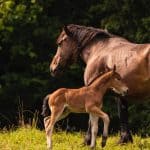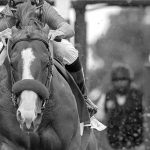Obedience vs Partnership
Obedience is required of our horses…in our dressage tests, our jumping classes, and our daily routine whether that routine is to safely cross a street, or simply lifting a hoof to be picked. We obtain it by rote; through repetition and a series of varying degrees of praise or correction, depending on the task at hand.
In fact, obedience is a wonderful thing, and when we train for obedience in conjunction with an agenda that is geared towards deeper partnership, our highest goals for the horse can be achieved. When we ignore partnership, and just look for the correct action, either through copious amounts of repetition, or punishment of anything BUT the correct action, this is when we see horses that begin to withdraw inside themselves. The eye becomes distant, the movement loses its joie de vivre, and eventually, the horse becomes uninterested in trying new things or stepping outside of its comfort zone.
As we train a horse through higher and higher levels of education, it is through nurturing its natural joie de vivre, that we can enhance the beauty of our partnership in a way that even the untrained eye of a non-horseman can spot. So, let us first give some examples of training for partnership rather than just for obedience:
Many young horses will enact a prancing jog when under saddle when they become excited. It is considered a fault to allow it because it is often used by the horse as an avoidance tactic later in its training, and once ingrained, it is quite annoying to correct. However, rather than punish the young horse for this behavior, which is a natural result of his excitement, we might give the aids for passage, and take advantage of this moment as a training opportunity rather than seeing it as an event requiring punishment. In this scenario, we might give the aid as if to say, “let me participate in this beautiful trot with you! Let me see even more!” With our participation (the aid for passage) we bring his attention back to us, we praise his intelligence and ability, and while we still have his attention, we redirect him into another exercise. This does not, however, mean we begin training this horse for passage when it is not yet mentally or physically capable for the formal training of it. This is after all, an exercise in partnership, not in passage (an upper level dressage movement that the horse may never formally learn, and that is ok!)
The same goes for an accidental lead change before the horse has begun formal training in flying lead changes. (See my article, The Canter Departure.) At no point prior to formal instruction on the flying lead should the horse be punished for executing this movement. Depending on the quality of the horse’s attitude, attention, or education, we may choose to simply ignore the change and make adjustment ourself. Here, we shift weight and change direction so the new lead is easier for the young horse to perform as he is still learning about his body and how best to carry a rider. Our focus in the early days must be on “forward” and “relaxed”, so if he succeeded in performing the change while remaining in both these states, you have actually given him a successful impromptu lesson for which we must be proud of him! If we are paying close enough attention, go ahead and give the aid for a flying change to coincide with his mistake, and praise the movement to set in the horse’s mind that he did something of interest. This is a very natural and organic way of learning for the horse, and it is a mindset that increases his curiosity as well as his interest in working through new exercises and movements as his training progresses.
When we approach our lessons with an air of joy, and desire for partnership, even surly horses begin to show interest. In keeping with our earlier flying lead change example, let us use a fault we occasionally see in a difficult horse as a sample methodology of working through a negative habit in a positive way: if the horse uses the flying lead change as an avoidance tactic to get out of correct work (not due to rider-error, which is actually more common), we do not punish the change of lead, rather we say, “ah, I see that you wish to work on counter canter.” The horse quickly realizes that counter canter is much harder than if he had just kept the original lead, and we have gained more of his respect as a consequence. In this way, we work WITH the body of the horse while influencing his mind and preserving his heart. We remain friends and begin to have an open and honest conversation from him.
A further example is when we use this same mindset in teaching a green horse to jump. Give him support, but let him experiment a little as well. Let him go up to it short, or leave a little long if he has the willfulness to do so – he learns much about his body and balance in carrying his rider during these early lessons – and praise him for his willingness alone, to go forward and over the obstacle even though everything wasn’t perfect. You will find that when we look for and praise all the things that went right, rather than harp on the one or two things that went wrong, our horses repay us with their devotion, give us more of their attention, and more reasons to be proud of them. It is through this holistic development that we progress to greatest advantage and effect.
Later in his training you will find that this positive energy we have quietly nurtured, as well as his natural joie de vivre that we have retained (or redeveloped), can fluidly be redirected into the brilliance of a movement, courage when facing obstacles, and adaptive intelligence when faced with a situation that requires problem solving.
Conversely, avoid working JUST on the body and the biodynamic correctness of a specific movement, for the movement in and of itself is a dead thing. You can lengthen a stride with gymnastic work, but without training the whole of the horse, what results will be a dull, mechanized caricature of the intended movement, very likely lacking in purity and only half of what it could have been. It is also worth it to mention here that when we repeatedly drill a horse in a movement that he is unsuccessful in achieving, the cause is most likely not willfulness or maliciousness, but rather, an underlying deficiency in a foundational prerequisite, or a pain point (inappropriate/ill-fitting tack, physical pain, prior trauma, etc.)
And so, this is partnership: we become both mentor and friend, and when we enter into it with our horses, there is not one among us who can deny that it changes the game greatly. Here, we see formerly bored, sour, or otherwise difficult and distracted horses beginning to show interest in learning and taking pleasure in showing off. There is more life to the gaits and bravery in the heart of a horse whose rider is not just a rider, but a true partner and companion.
Without words, we know when our partners (human or otherwise) are afraid, tired, angry or happy, and it is through this intimate knowingness, seen through the eyes of flexibility and appreciation that we gain inspiration and great joy in our daily work with our horses.

The bud
stands for all things,
even for those things that don’t flower,
for everything flowers, from within, of self-blessing;
though sometimes it is necessary
to reteach a thing its loveliness,
to put a hand on its brow
of the flower
and retell it in words and in touch
it is lovely
until it flowers again from within, of self-blessing…
-Excerpted from “Saint Francis and the Sow”, by Galway KinnellKinnell’s words are sophic, simple, and utterly beautiful. Through his poetry, he speaks to the heart of this matter exactly that which my simple prose lacks. Let it become a part of your program if it isn’t already, and may it be an inaudible whisper quietly influencing your every thought, with every horse that you work with. This is the invisible line: anyone can teach an animal to obedience, but to teach a thing to know itself as something special, both lovely, and greatly beloved? This is the difference between obedience and partnership.
When we have taught our horses to know they are lovely and beloved, regardless of the mistakes they may make on a given day, that is when true partnership happens. With practice, you will discover that most of the time, there is no need to let a horse know they are making mistakes. In conjunction with mindful and structured lessons, your horse’s required obedience will naturally occur (or said in another way; obedience should be a natural output of the partnership process.)
Adaptive Development EQ uses this approach to training. It sets about a quality of enhanced, long term performance that puts partnership first, and would have been unachievable any other way.
Euki is the founder of Adaptive Development EQ and currently coaching and consulting in Denver, Colorado. She loves helping people get inspired about the developmental process of holistic/whole-horse training, and is on a mission to help riders and owners rediscover their horses, and fall in love with them all over again.






